Uber's Strategic Management: PESTLE, VRIO, and Porter's Five Forces
VerifiedAdded on 2023/01/04
|18
|6092
|434
Report
AI Summary
This report provides a comprehensive analysis of Uber's business strategy, examining both the macro and micro environments that influence its operations. It utilizes frameworks such as PESTLE to assess political, economic, social, technological, legal, and environmental factors impacting Uber. The VRIO model is applied to evaluate Uber's internal resources and capabilities, focusing on value, rarity, imitability, and organization. Porter's Five Forces model is used to analyze the competitive landscape of the market sector in which Uber operates. Furthermore, the report explores strategic planning for Uber, incorporating theories, concepts, and models to devise effective strategies. The analysis also touches upon stakeholder analysis, SWOT analysis, McKinsey's 7S framework, Ansoff growth Matrix and Porters Generic model strategic management plan. The report aims to provide a thorough understanding of the factors that drive Uber's strategic decisions and competitive positioning.
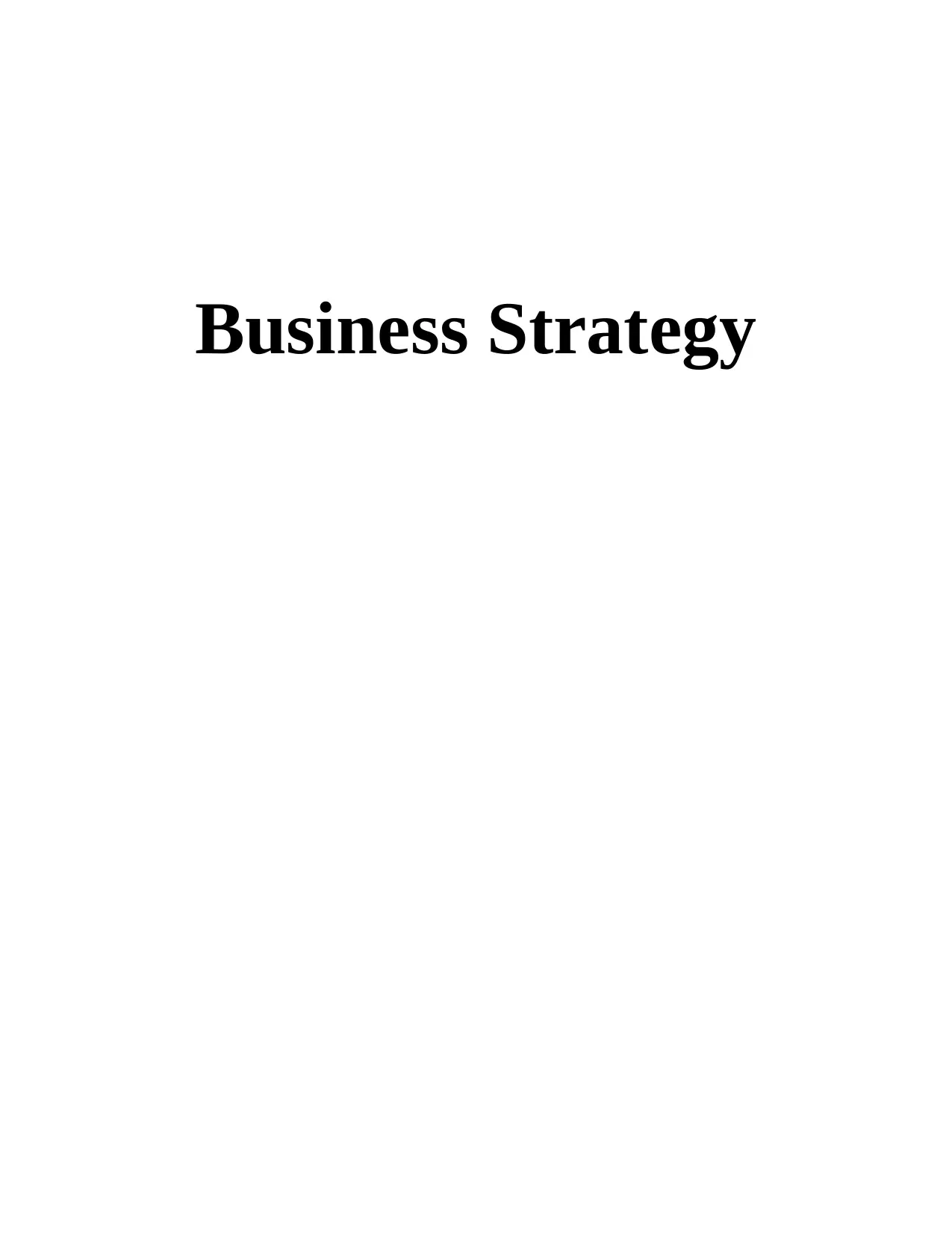
Business Strategy
Paraphrase This Document
Need a fresh take? Get an instant paraphrase of this document with our AI Paraphraser
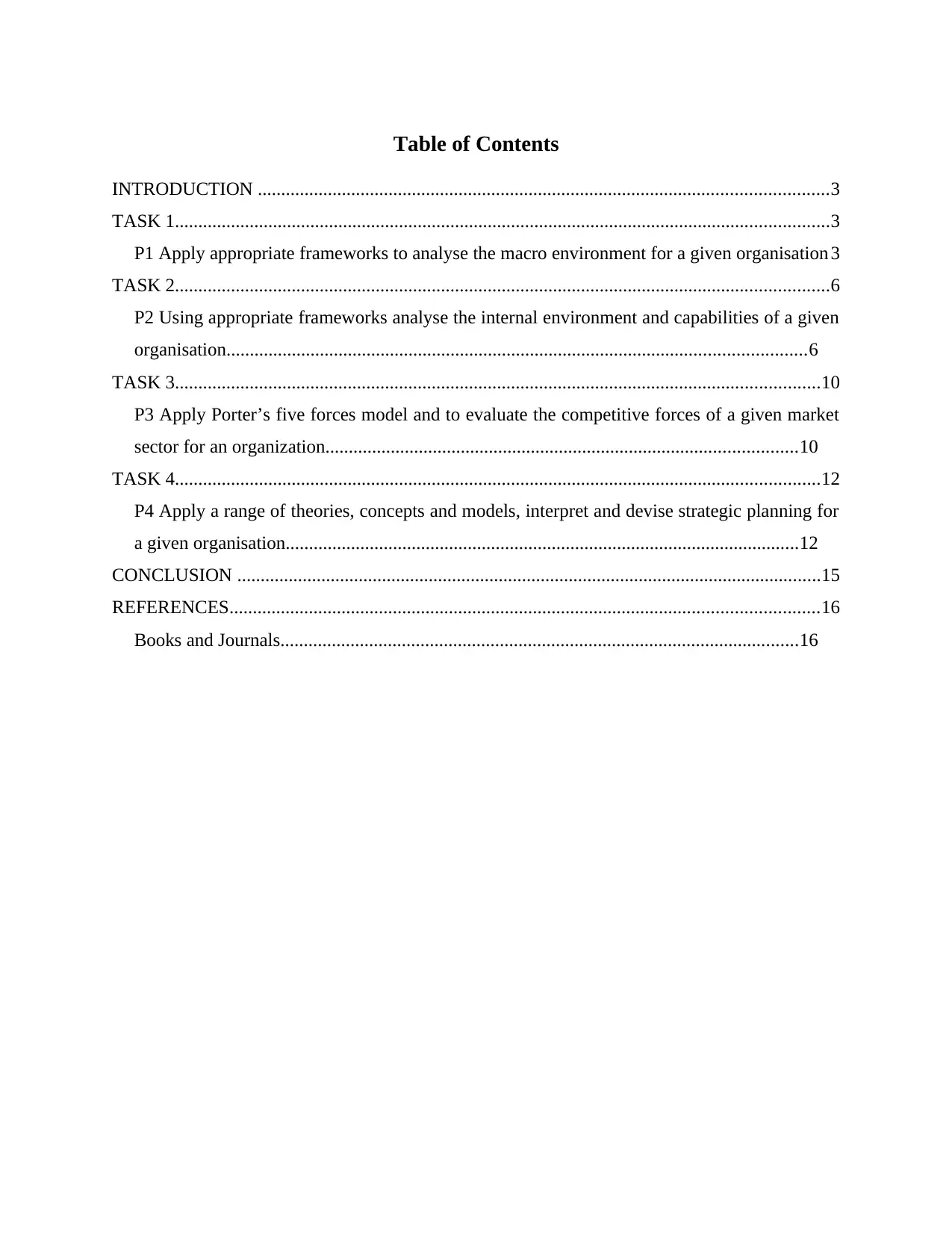
Table of Contents
INTRODUCTION ..........................................................................................................................3
TASK 1............................................................................................................................................3
P1 Apply appropriate frameworks to analyse the macro environment for a given organisation 3
TASK 2............................................................................................................................................6
P2 Using appropriate frameworks analyse the internal environment and capabilities of a given
organisation............................................................................................................................6
TASK 3..........................................................................................................................................10
P3 Apply Porter’s five forces model and to evaluate the competitive forces of a given market
sector for an organization.....................................................................................................10
TASK 4..........................................................................................................................................12
P4 Apply a range of theories, concepts and models, interpret and devise strategic planning for
a given organisation..............................................................................................................12
CONCLUSION .............................................................................................................................15
REFERENCES..............................................................................................................................16
Books and Journals...............................................................................................................16
INTRODUCTION ..........................................................................................................................3
TASK 1............................................................................................................................................3
P1 Apply appropriate frameworks to analyse the macro environment for a given organisation 3
TASK 2............................................................................................................................................6
P2 Using appropriate frameworks analyse the internal environment and capabilities of a given
organisation............................................................................................................................6
TASK 3..........................................................................................................................................10
P3 Apply Porter’s five forces model and to evaluate the competitive forces of a given market
sector for an organization.....................................................................................................10
TASK 4..........................................................................................................................................12
P4 Apply a range of theories, concepts and models, interpret and devise strategic planning for
a given organisation..............................................................................................................12
CONCLUSION .............................................................................................................................15
REFERENCES..............................................................................................................................16
Books and Journals...............................................................................................................16
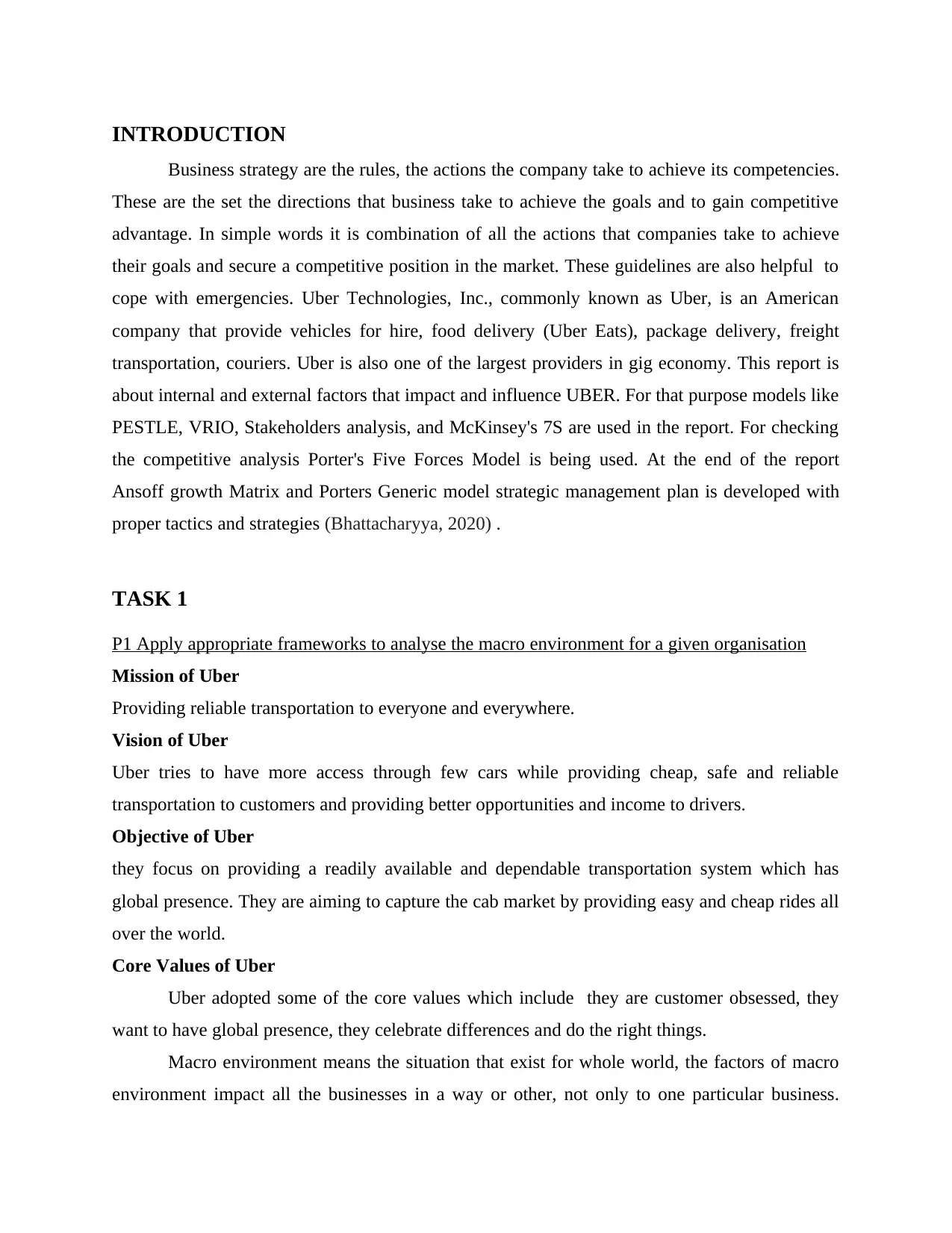
INTRODUCTION
Business strategy are the rules, the actions the company take to achieve its competencies.
These are the set the directions that business take to achieve the goals and to gain competitive
advantage. In simple words it is combination of all the actions that companies take to achieve
their goals and secure a competitive position in the market. These guidelines are also helpful to
cope with emergencies. Uber Technologies, Inc., commonly known as Uber, is an American
company that provide vehicles for hire, food delivery (Uber Eats), package delivery, freight
transportation, couriers. Uber is also one of the largest providers in gig economy. This report is
about internal and external factors that impact and influence UBER. For that purpose models like
PESTLE, VRIO, Stakeholders analysis, and McKinsey's 7S are used in the report. For checking
the competitive analysis Porter's Five Forces Model is being used. At the end of the report
Ansoff growth Matrix and Porters Generic model strategic management plan is developed with
proper tactics and strategies (Bhattacharyya, 2020) .
TASK 1
P1 Apply appropriate frameworks to analyse the macro environment for a given organisation
Mission of Uber
Providing reliable transportation to everyone and everywhere.
Vision of Uber
Uber tries to have more access through few cars while providing cheap, safe and reliable
transportation to customers and providing better opportunities and income to drivers.
Objective of Uber
they focus on providing a readily available and dependable transportation system which has
global presence. They are aiming to capture the cab market by providing easy and cheap rides all
over the world.
Core Values of Uber
Uber adopted some of the core values which include they are customer obsessed, they
want to have global presence, they celebrate differences and do the right things.
Macro environment means the situation that exist for whole world, the factors of macro
environment impact all the businesses in a way or other, not only to one particular business.
Business strategy are the rules, the actions the company take to achieve its competencies.
These are the set the directions that business take to achieve the goals and to gain competitive
advantage. In simple words it is combination of all the actions that companies take to achieve
their goals and secure a competitive position in the market. These guidelines are also helpful to
cope with emergencies. Uber Technologies, Inc., commonly known as Uber, is an American
company that provide vehicles for hire, food delivery (Uber Eats), package delivery, freight
transportation, couriers. Uber is also one of the largest providers in gig economy. This report is
about internal and external factors that impact and influence UBER. For that purpose models like
PESTLE, VRIO, Stakeholders analysis, and McKinsey's 7S are used in the report. For checking
the competitive analysis Porter's Five Forces Model is being used. At the end of the report
Ansoff growth Matrix and Porters Generic model strategic management plan is developed with
proper tactics and strategies (Bhattacharyya, 2020) .
TASK 1
P1 Apply appropriate frameworks to analyse the macro environment for a given organisation
Mission of Uber
Providing reliable transportation to everyone and everywhere.
Vision of Uber
Uber tries to have more access through few cars while providing cheap, safe and reliable
transportation to customers and providing better opportunities and income to drivers.
Objective of Uber
they focus on providing a readily available and dependable transportation system which has
global presence. They are aiming to capture the cab market by providing easy and cheap rides all
over the world.
Core Values of Uber
Uber adopted some of the core values which include they are customer obsessed, they
want to have global presence, they celebrate differences and do the right things.
Macro environment means the situation that exist for whole world, the factors of macro
environment impact all the businesses in a way or other, not only to one particular business.
⊘ This is a preview!⊘
Do you want full access?
Subscribe today to unlock all pages.

Trusted by 1+ million students worldwide
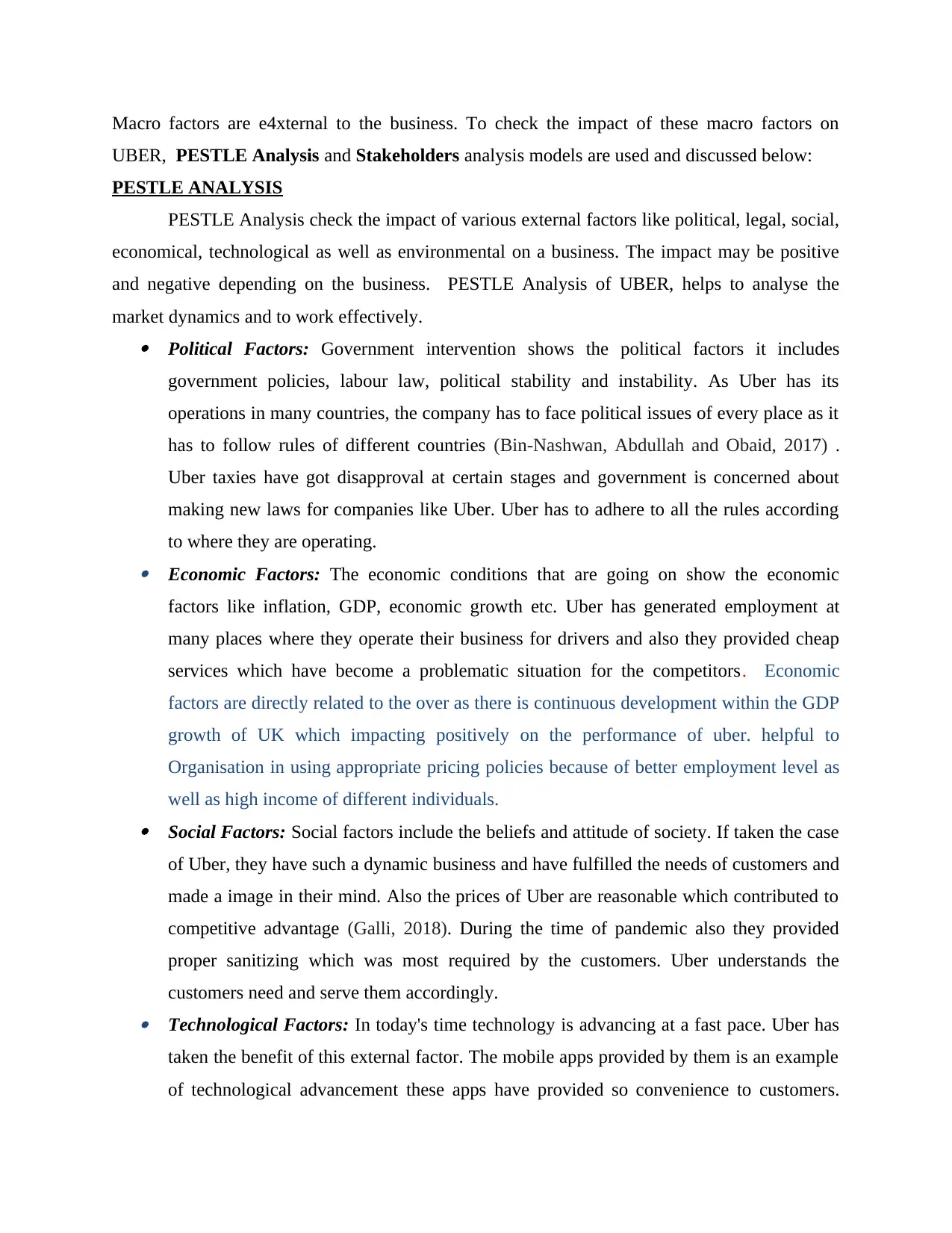
Macro factors are e4xternal to the business. To check the impact of these macro factors on
UBER, PESTLE Analysis and Stakeholders analysis models are used and discussed below:
PESTLE ANALYSIS
PESTLE Analysis check the impact of various external factors like political, legal, social,
economical, technological as well as environmental on a business. The impact may be positive
and negative depending on the business. PESTLE Analysis of UBER, helps to analyse the
market dynamics and to work effectively. Political Factors: Government intervention shows the political factors it includes
government policies, labour law, political stability and instability. As Uber has its
operations in many countries, the company has to face political issues of every place as it
has to follow rules of different countries (Bin-Nashwan, Abdullah and Obaid, 2017) .
Uber taxies have got disapproval at certain stages and government is concerned about
making new laws for companies like Uber. Uber has to adhere to all the rules according
to where they are operating. Economic Factors: The economic conditions that are going on show the economic
factors like inflation, GDP, economic growth etc. Uber has generated employment at
many places where they operate their business for drivers and also they provided cheap
services which have become a problematic situation for the competitors. Economic
factors are directly related to the over as there is continuous development within the GDP
growth of UK which impacting positively on the performance of uber. helpful to
Organisation in using appropriate pricing policies because of better employment level as
well as high income of different individuals. Social Factors: Social factors include the beliefs and attitude of society. If taken the case
of Uber, they have such a dynamic business and have fulfilled the needs of customers and
made a image in their mind. Also the prices of Uber are reasonable which contributed to
competitive advantage (Galli, 2018). During the time of pandemic also they provided
proper sanitizing which was most required by the customers. Uber understands the
customers need and serve them accordingly. Technological Factors: In today's time technology is advancing at a fast pace. Uber has
taken the benefit of this external factor. The mobile apps provided by them is an example
of technological advancement these apps have provided so convenience to customers.
UBER, PESTLE Analysis and Stakeholders analysis models are used and discussed below:
PESTLE ANALYSIS
PESTLE Analysis check the impact of various external factors like political, legal, social,
economical, technological as well as environmental on a business. The impact may be positive
and negative depending on the business. PESTLE Analysis of UBER, helps to analyse the
market dynamics and to work effectively. Political Factors: Government intervention shows the political factors it includes
government policies, labour law, political stability and instability. As Uber has its
operations in many countries, the company has to face political issues of every place as it
has to follow rules of different countries (Bin-Nashwan, Abdullah and Obaid, 2017) .
Uber taxies have got disapproval at certain stages and government is concerned about
making new laws for companies like Uber. Uber has to adhere to all the rules according
to where they are operating. Economic Factors: The economic conditions that are going on show the economic
factors like inflation, GDP, economic growth etc. Uber has generated employment at
many places where they operate their business for drivers and also they provided cheap
services which have become a problematic situation for the competitors. Economic
factors are directly related to the over as there is continuous development within the GDP
growth of UK which impacting positively on the performance of uber. helpful to
Organisation in using appropriate pricing policies because of better employment level as
well as high income of different individuals. Social Factors: Social factors include the beliefs and attitude of society. If taken the case
of Uber, they have such a dynamic business and have fulfilled the needs of customers and
made a image in their mind. Also the prices of Uber are reasonable which contributed to
competitive advantage (Galli, 2018). During the time of pandemic also they provided
proper sanitizing which was most required by the customers. Uber understands the
customers need and serve them accordingly. Technological Factors: In today's time technology is advancing at a fast pace. Uber has
taken the benefit of this external factor. The mobile apps provided by them is an example
of technological advancement these apps have provided so convenience to customers.
Paraphrase This Document
Need a fresh take? Get an instant paraphrase of this document with our AI Paraphraser
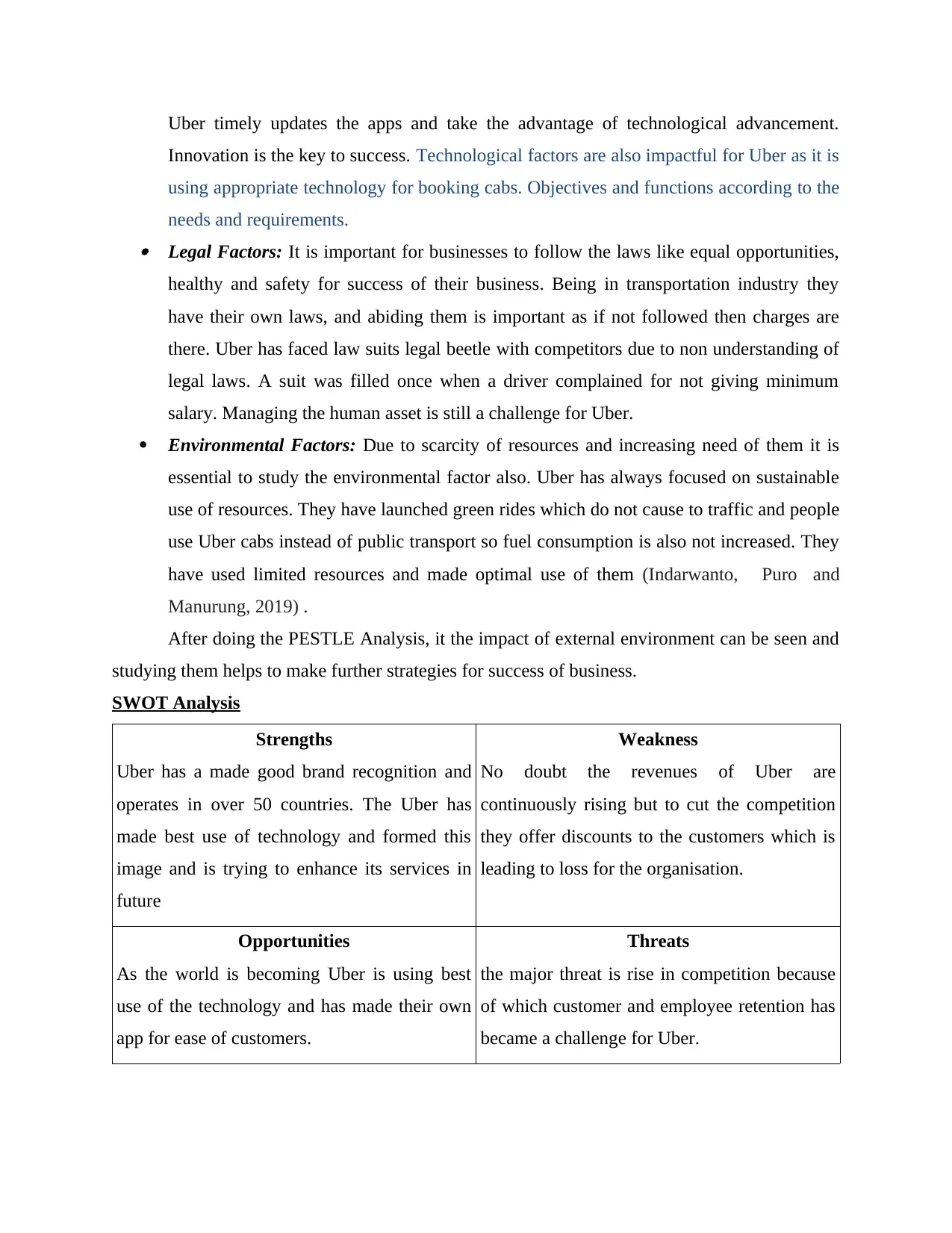
Uber timely updates the apps and take the advantage of technological advancement.
Innovation is the key to success. Technological factors are also impactful for Uber as it is
using appropriate technology for booking cabs. Objectives and functions according to the
needs and requirements. Legal Factors: It is important for businesses to follow the laws like equal opportunities,
healthy and safety for success of their business. Being in transportation industry they
have their own laws, and abiding them is important as if not followed then charges are
there. Uber has faced law suits legal beetle with competitors due to non understanding of
legal laws. A suit was filled once when a driver complained for not giving minimum
salary. Managing the human asset is still a challenge for Uber.
Environmental Factors: Due to scarcity of resources and increasing need of them it is
essential to study the environmental factor also. Uber has always focused on sustainable
use of resources. They have launched green rides which do not cause to traffic and people
use Uber cabs instead of public transport so fuel consumption is also not increased. They
have used limited resources and made optimal use of them (Indarwanto, Puro and
Manurung, 2019) .
After doing the PESTLE Analysis, it the impact of external environment can be seen and
studying them helps to make further strategies for success of business.
SWOT Analysis
Strengths
Uber has a made good brand recognition and
operates in over 50 countries. The Uber has
made best use of technology and formed this
image and is trying to enhance its services in
future
Weakness
No doubt the revenues of Uber are
continuously rising but to cut the competition
they offer discounts to the customers which is
leading to loss for the organisation.
Opportunities
As the world is becoming Uber is using best
use of the technology and has made their own
app for ease of customers.
Threats
the major threat is rise in competition because
of which customer and employee retention has
became a challenge for Uber.
Innovation is the key to success. Technological factors are also impactful for Uber as it is
using appropriate technology for booking cabs. Objectives and functions according to the
needs and requirements. Legal Factors: It is important for businesses to follow the laws like equal opportunities,
healthy and safety for success of their business. Being in transportation industry they
have their own laws, and abiding them is important as if not followed then charges are
there. Uber has faced law suits legal beetle with competitors due to non understanding of
legal laws. A suit was filled once when a driver complained for not giving minimum
salary. Managing the human asset is still a challenge for Uber.
Environmental Factors: Due to scarcity of resources and increasing need of them it is
essential to study the environmental factor also. Uber has always focused on sustainable
use of resources. They have launched green rides which do not cause to traffic and people
use Uber cabs instead of public transport so fuel consumption is also not increased. They
have used limited resources and made optimal use of them (Indarwanto, Puro and
Manurung, 2019) .
After doing the PESTLE Analysis, it the impact of external environment can be seen and
studying them helps to make further strategies for success of business.
SWOT Analysis
Strengths
Uber has a made good brand recognition and
operates in over 50 countries. The Uber has
made best use of technology and formed this
image and is trying to enhance its services in
future
Weakness
No doubt the revenues of Uber are
continuously rising but to cut the competition
they offer discounts to the customers which is
leading to loss for the organisation.
Opportunities
As the world is becoming Uber is using best
use of the technology and has made their own
app for ease of customers.
Threats
the major threat is rise in competition because
of which customer and employee retention has
became a challenge for Uber.
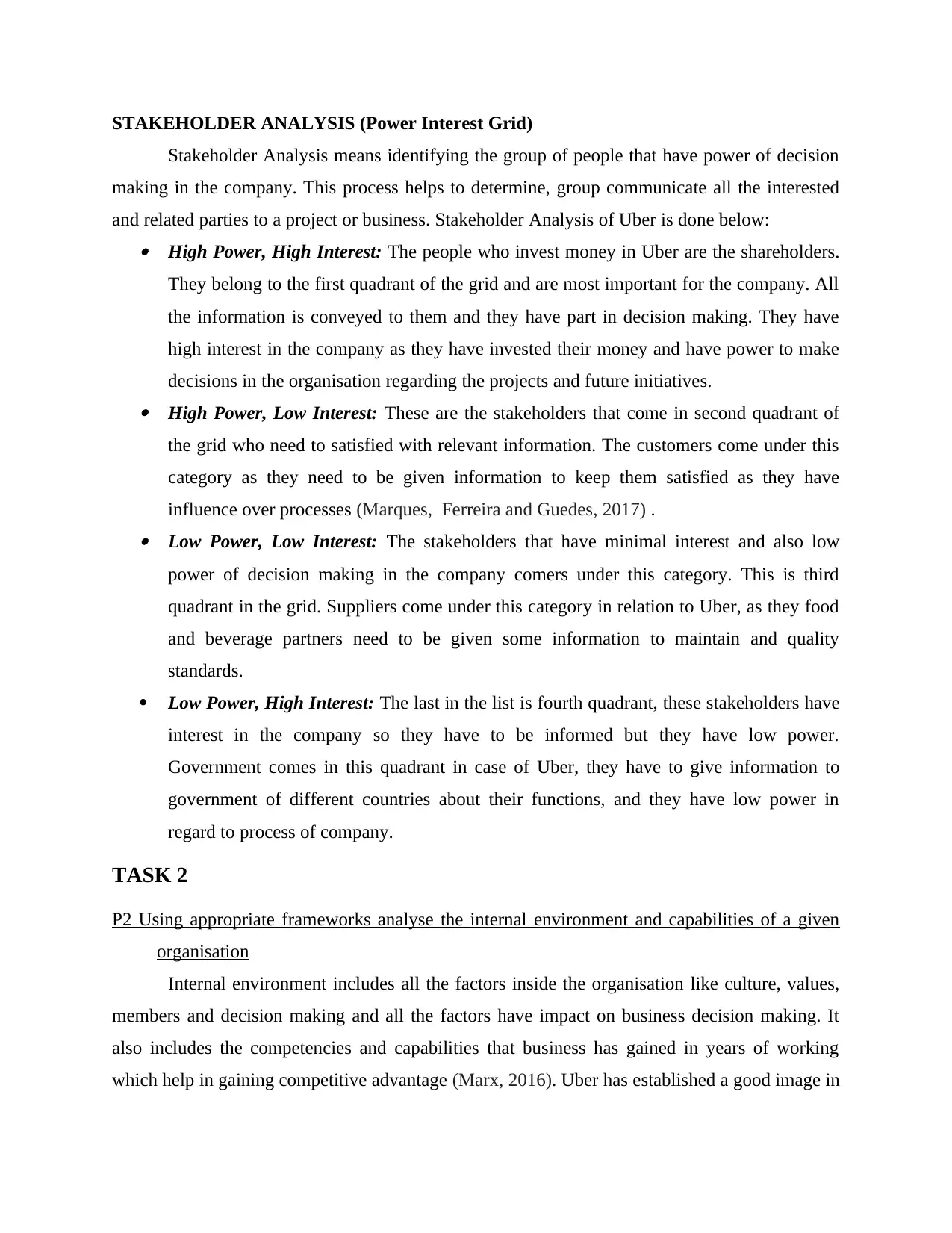
STAKEHOLDER ANALYSIS (Power Interest Grid)
Stakeholder Analysis means identifying the group of people that have power of decision
making in the company. This process helps to determine, group communicate all the interested
and related parties to a project or business. Stakeholder Analysis of Uber is done below: High Power, High Interest: The people who invest money in Uber are the shareholders.
They belong to the first quadrant of the grid and are most important for the company. All
the information is conveyed to them and they have part in decision making. They have
high interest in the company as they have invested their money and have power to make
decisions in the organisation regarding the projects and future initiatives. High Power, Low Interest: These are the stakeholders that come in second quadrant of
the grid who need to satisfied with relevant information. The customers come under this
category as they need to be given information to keep them satisfied as they have
influence over processes (Marques, Ferreira and Guedes, 2017) . Low Power, Low Interest: The stakeholders that have minimal interest and also low
power of decision making in the company comers under this category. This is third
quadrant in the grid. Suppliers come under this category in relation to Uber, as they food
and beverage partners need to be given some information to maintain and quality
standards.
Low Power, High Interest: The last in the list is fourth quadrant, these stakeholders have
interest in the company so they have to be informed but they have low power.
Government comes in this quadrant in case of Uber, they have to give information to
government of different countries about their functions, and they have low power in
regard to process of company.
TASK 2
P2 Using appropriate frameworks analyse the internal environment and capabilities of a given
organisation
Internal environment includes all the factors inside the organisation like culture, values,
members and decision making and all the factors have impact on business decision making. It
also includes the competencies and capabilities that business has gained in years of working
which help in gaining competitive advantage (Marx, 2016). Uber has established a good image in
Stakeholder Analysis means identifying the group of people that have power of decision
making in the company. This process helps to determine, group communicate all the interested
and related parties to a project or business. Stakeholder Analysis of Uber is done below: High Power, High Interest: The people who invest money in Uber are the shareholders.
They belong to the first quadrant of the grid and are most important for the company. All
the information is conveyed to them and they have part in decision making. They have
high interest in the company as they have invested their money and have power to make
decisions in the organisation regarding the projects and future initiatives. High Power, Low Interest: These are the stakeholders that come in second quadrant of
the grid who need to satisfied with relevant information. The customers come under this
category as they need to be given information to keep them satisfied as they have
influence over processes (Marques, Ferreira and Guedes, 2017) . Low Power, Low Interest: The stakeholders that have minimal interest and also low
power of decision making in the company comers under this category. This is third
quadrant in the grid. Suppliers come under this category in relation to Uber, as they food
and beverage partners need to be given some information to maintain and quality
standards.
Low Power, High Interest: The last in the list is fourth quadrant, these stakeholders have
interest in the company so they have to be informed but they have low power.
Government comes in this quadrant in case of Uber, they have to give information to
government of different countries about their functions, and they have low power in
regard to process of company.
TASK 2
P2 Using appropriate frameworks analyse the internal environment and capabilities of a given
organisation
Internal environment includes all the factors inside the organisation like culture, values,
members and decision making and all the factors have impact on business decision making. It
also includes the competencies and capabilities that business has gained in years of working
which help in gaining competitive advantage (Marx, 2016). Uber has established a good image in
⊘ This is a preview!⊘
Do you want full access?
Subscribe today to unlock all pages.

Trusted by 1+ million students worldwide
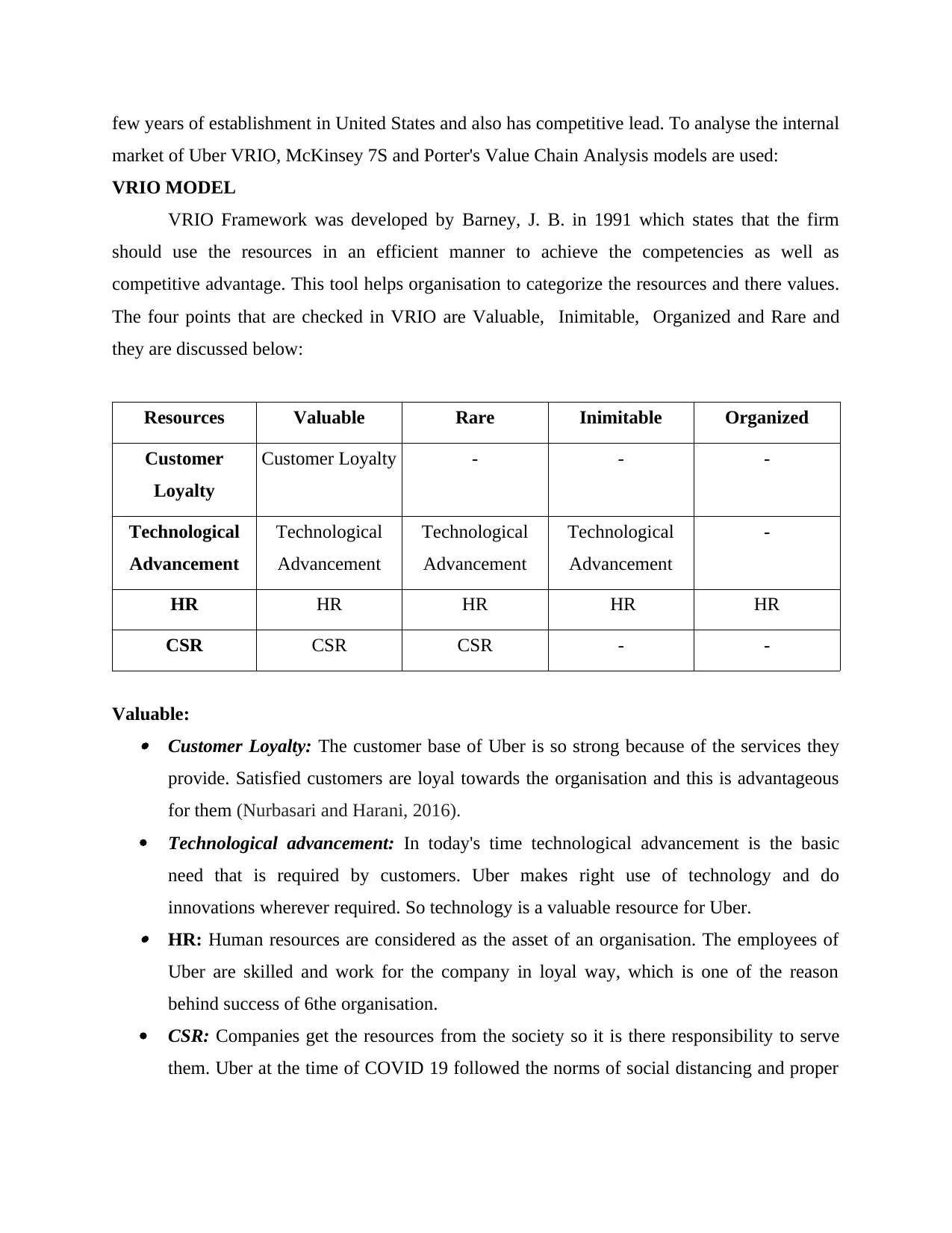
few years of establishment in United States and also has competitive lead. To analyse the internal
market of Uber VRIO, McKinsey 7S and Porter's Value Chain Analysis models are used:
VRIO MODEL
VRIO Framework was developed by Barney, J. B. in 1991 which states that the firm
should use the resources in an efficient manner to achieve the competencies as well as
competitive advantage. This tool helps organisation to categorize the resources and there values.
The four points that are checked in VRIO are Valuable, Inimitable, Organized and Rare and
they are discussed below:
Resources Valuable Rare Inimitable Organized
Customer
Loyalty
Customer Loyalty - - -
Technological
Advancement
Technological
Advancement
Technological
Advancement
Technological
Advancement
-
HR HR HR HR HR
CSR CSR CSR - -
Valuable: Customer Loyalty: The customer base of Uber is so strong because of the services they
provide. Satisfied customers are loyal towards the organisation and this is advantageous
for them (Nurbasari and Harani, 2016).
Technological advancement: In today's time technological advancement is the basic
need that is required by customers. Uber makes right use of technology and do
innovations wherever required. So technology is a valuable resource for Uber. HR: Human resources are considered as the asset of an organisation. The employees of
Uber are skilled and work for the company in loyal way, which is one of the reason
behind success of 6the organisation.
CSR: Companies get the resources from the society so it is there responsibility to serve
them. Uber at the time of COVID 19 followed the norms of social distancing and proper
market of Uber VRIO, McKinsey 7S and Porter's Value Chain Analysis models are used:
VRIO MODEL
VRIO Framework was developed by Barney, J. B. in 1991 which states that the firm
should use the resources in an efficient manner to achieve the competencies as well as
competitive advantage. This tool helps organisation to categorize the resources and there values.
The four points that are checked in VRIO are Valuable, Inimitable, Organized and Rare and
they are discussed below:
Resources Valuable Rare Inimitable Organized
Customer
Loyalty
Customer Loyalty - - -
Technological
Advancement
Technological
Advancement
Technological
Advancement
Technological
Advancement
-
HR HR HR HR HR
CSR CSR CSR - -
Valuable: Customer Loyalty: The customer base of Uber is so strong because of the services they
provide. Satisfied customers are loyal towards the organisation and this is advantageous
for them (Nurbasari and Harani, 2016).
Technological advancement: In today's time technological advancement is the basic
need that is required by customers. Uber makes right use of technology and do
innovations wherever required. So technology is a valuable resource for Uber. HR: Human resources are considered as the asset of an organisation. The employees of
Uber are skilled and work for the company in loyal way, which is one of the reason
behind success of 6the organisation.
CSR: Companies get the resources from the society so it is there responsibility to serve
them. Uber at the time of COVID 19 followed the norms of social distancing and proper
Paraphrase This Document
Need a fresh take? Get an instant paraphrase of this document with our AI Paraphraser
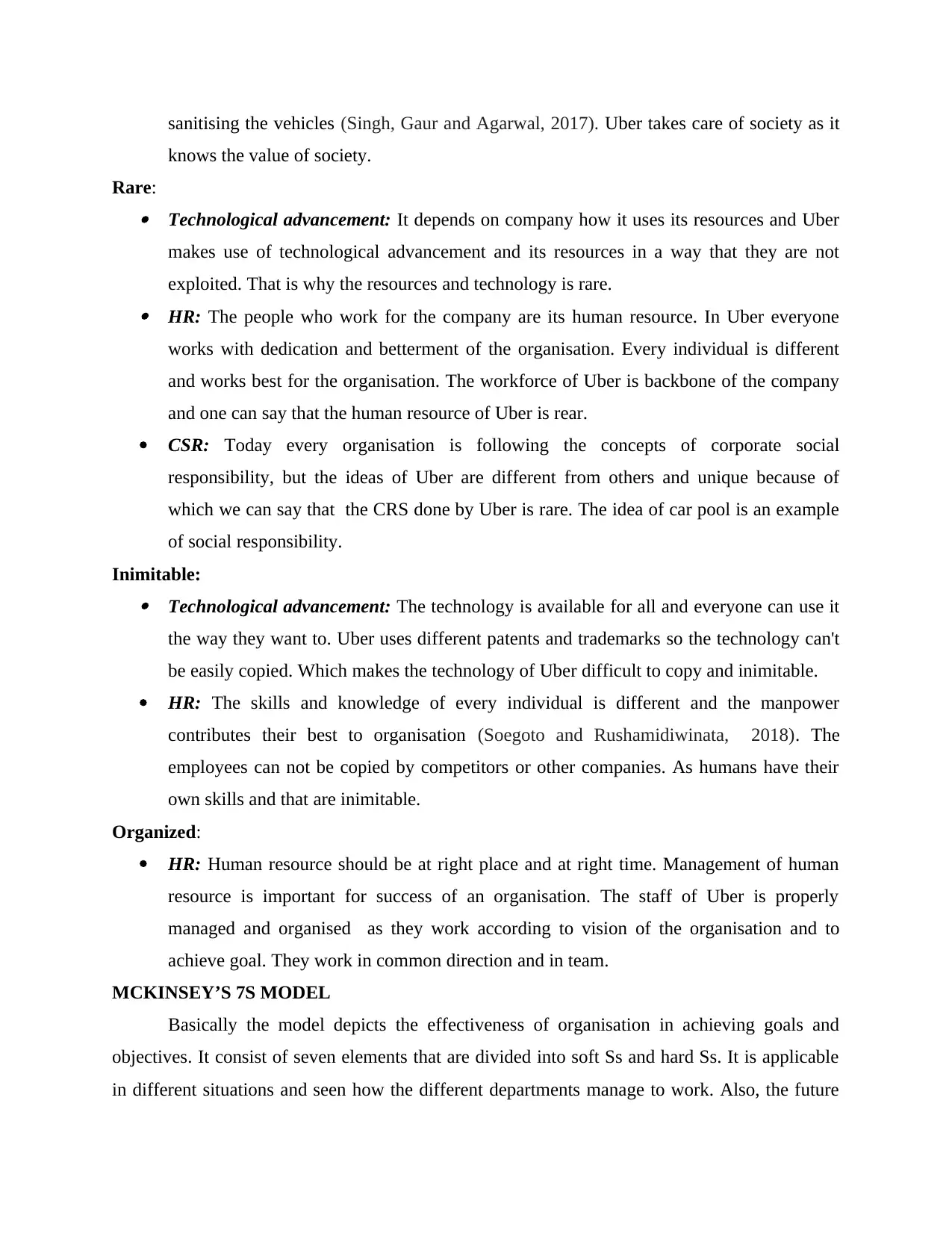
sanitising the vehicles (Singh, Gaur and Agarwal, 2017). Uber takes care of society as it
knows the value of society.
Rare: Technological advancement: It depends on company how it uses its resources and Uber
makes use of technological advancement and its resources in a way that they are not
exploited. That is why the resources and technology is rare. HR: The people who work for the company are its human resource. In Uber everyone
works with dedication and betterment of the organisation. Every individual is different
and works best for the organisation. The workforce of Uber is backbone of the company
and one can say that the human resource of Uber is rear.
CSR: Today every organisation is following the concepts of corporate social
responsibility, but the ideas of Uber are different from others and unique because of
which we can say that the CRS done by Uber is rare. The idea of car pool is an example
of social responsibility.
Inimitable: Technological advancement: The technology is available for all and everyone can use it
the way they want to. Uber uses different patents and trademarks so the technology can't
be easily copied. Which makes the technology of Uber difficult to copy and inimitable.
HR: The skills and knowledge of every individual is different and the manpower
contributes their best to organisation (Soegoto and Rushamidiwinata, 2018). The
employees can not be copied by competitors or other companies. As humans have their
own skills and that are inimitable.
Organized:
HR: Human resource should be at right place and at right time. Management of human
resource is important for success of an organisation. The staff of Uber is properly
managed and organised as they work according to vision of the organisation and to
achieve goal. They work in common direction and in team.
MCKINSEY’S 7S MODEL
Basically the model depicts the effectiveness of organisation in achieving goals and
objectives. It consist of seven elements that are divided into soft Ss and hard Ss. It is applicable
in different situations and seen how the different departments manage to work. Also, the future
knows the value of society.
Rare: Technological advancement: It depends on company how it uses its resources and Uber
makes use of technological advancement and its resources in a way that they are not
exploited. That is why the resources and technology is rare. HR: The people who work for the company are its human resource. In Uber everyone
works with dedication and betterment of the organisation. Every individual is different
and works best for the organisation. The workforce of Uber is backbone of the company
and one can say that the human resource of Uber is rear.
CSR: Today every organisation is following the concepts of corporate social
responsibility, but the ideas of Uber are different from others and unique because of
which we can say that the CRS done by Uber is rare. The idea of car pool is an example
of social responsibility.
Inimitable: Technological advancement: The technology is available for all and everyone can use it
the way they want to. Uber uses different patents and trademarks so the technology can't
be easily copied. Which makes the technology of Uber difficult to copy and inimitable.
HR: The skills and knowledge of every individual is different and the manpower
contributes their best to organisation (Soegoto and Rushamidiwinata, 2018). The
employees can not be copied by competitors or other companies. As humans have their
own skills and that are inimitable.
Organized:
HR: Human resource should be at right place and at right time. Management of human
resource is important for success of an organisation. The staff of Uber is properly
managed and organised as they work according to vision of the organisation and to
achieve goal. They work in common direction and in team.
MCKINSEY’S 7S MODEL
Basically the model depicts the effectiveness of organisation in achieving goals and
objectives. It consist of seven elements that are divided into soft Ss and hard Ss. It is applicable
in different situations and seen how the different departments manage to work. Also, the future
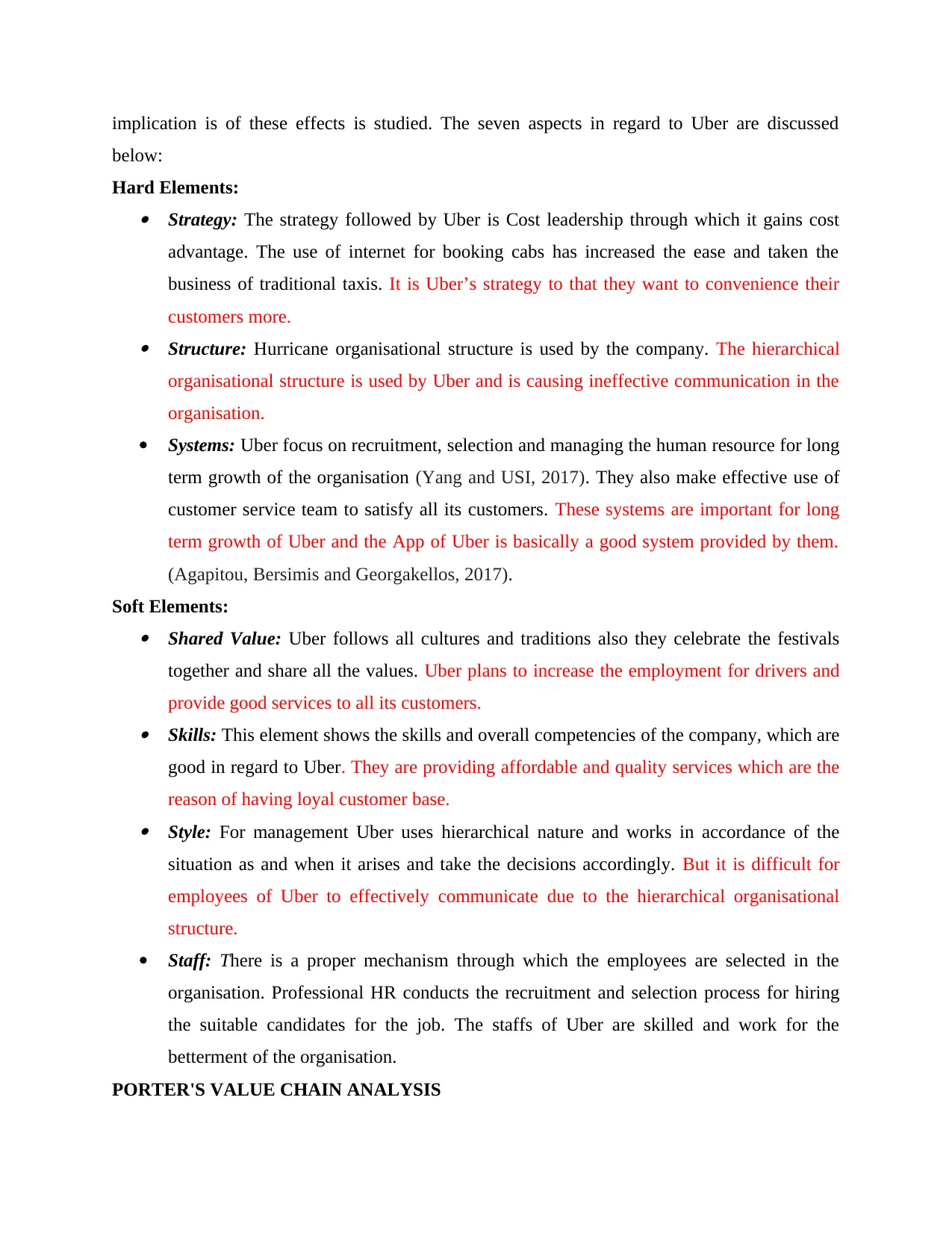
implication is of these effects is studied. The seven aspects in regard to Uber are discussed
below:
Hard Elements: Strategy: The strategy followed by Uber is Cost leadership through which it gains cost
advantage. The use of internet for booking cabs has increased the ease and taken the
business of traditional taxis. It is Uber’s strategy to that they want to convenience their
customers more. Structure: Hurricane organisational structure is used by the company. The hierarchical
organisational structure is used by Uber and is causing ineffective communication in the
organisation.
Systems: Uber focus on recruitment, selection and managing the human resource for long
term growth of the organisation (Yang and USI, 2017). They also make effective use of
customer service team to satisfy all its customers. These systems are important for long
term growth of Uber and the App of Uber is basically a good system provided by them.
(Agapitou, Bersimis and Georgakellos, 2017).
Soft Elements: Shared Value: Uber follows all cultures and traditions also they celebrate the festivals
together and share all the values. Uber plans to increase the employment for drivers and
provide good services to all its customers. Skills: This element shows the skills and overall competencies of the company, which are
good in regard to Uber. They are providing affordable and quality services which are the
reason of having loyal customer base. Style: For management Uber uses hierarchical nature and works in accordance of the
situation as and when it arises and take the decisions accordingly. But it is difficult for
employees of Uber to effectively communicate due to the hierarchical organisational
structure.
Staff: There is a proper mechanism through which the employees are selected in the
organisation. Professional HR conducts the recruitment and selection process for hiring
the suitable candidates for the job. The staffs of Uber are skilled and work for the
betterment of the organisation.
PORTER'S VALUE CHAIN ANALYSIS
below:
Hard Elements: Strategy: The strategy followed by Uber is Cost leadership through which it gains cost
advantage. The use of internet for booking cabs has increased the ease and taken the
business of traditional taxis. It is Uber’s strategy to that they want to convenience their
customers more. Structure: Hurricane organisational structure is used by the company. The hierarchical
organisational structure is used by Uber and is causing ineffective communication in the
organisation.
Systems: Uber focus on recruitment, selection and managing the human resource for long
term growth of the organisation (Yang and USI, 2017). They also make effective use of
customer service team to satisfy all its customers. These systems are important for long
term growth of Uber and the App of Uber is basically a good system provided by them.
(Agapitou, Bersimis and Georgakellos, 2017).
Soft Elements: Shared Value: Uber follows all cultures and traditions also they celebrate the festivals
together and share all the values. Uber plans to increase the employment for drivers and
provide good services to all its customers. Skills: This element shows the skills and overall competencies of the company, which are
good in regard to Uber. They are providing affordable and quality services which are the
reason of having loyal customer base. Style: For management Uber uses hierarchical nature and works in accordance of the
situation as and when it arises and take the decisions accordingly. But it is difficult for
employees of Uber to effectively communicate due to the hierarchical organisational
structure.
Staff: There is a proper mechanism through which the employees are selected in the
organisation. Professional HR conducts the recruitment and selection process for hiring
the suitable candidates for the job. The staffs of Uber are skilled and work for the
betterment of the organisation.
PORTER'S VALUE CHAIN ANALYSIS
⊘ This is a preview!⊘
Do you want full access?
Subscribe today to unlock all pages.

Trusted by 1+ million students worldwide
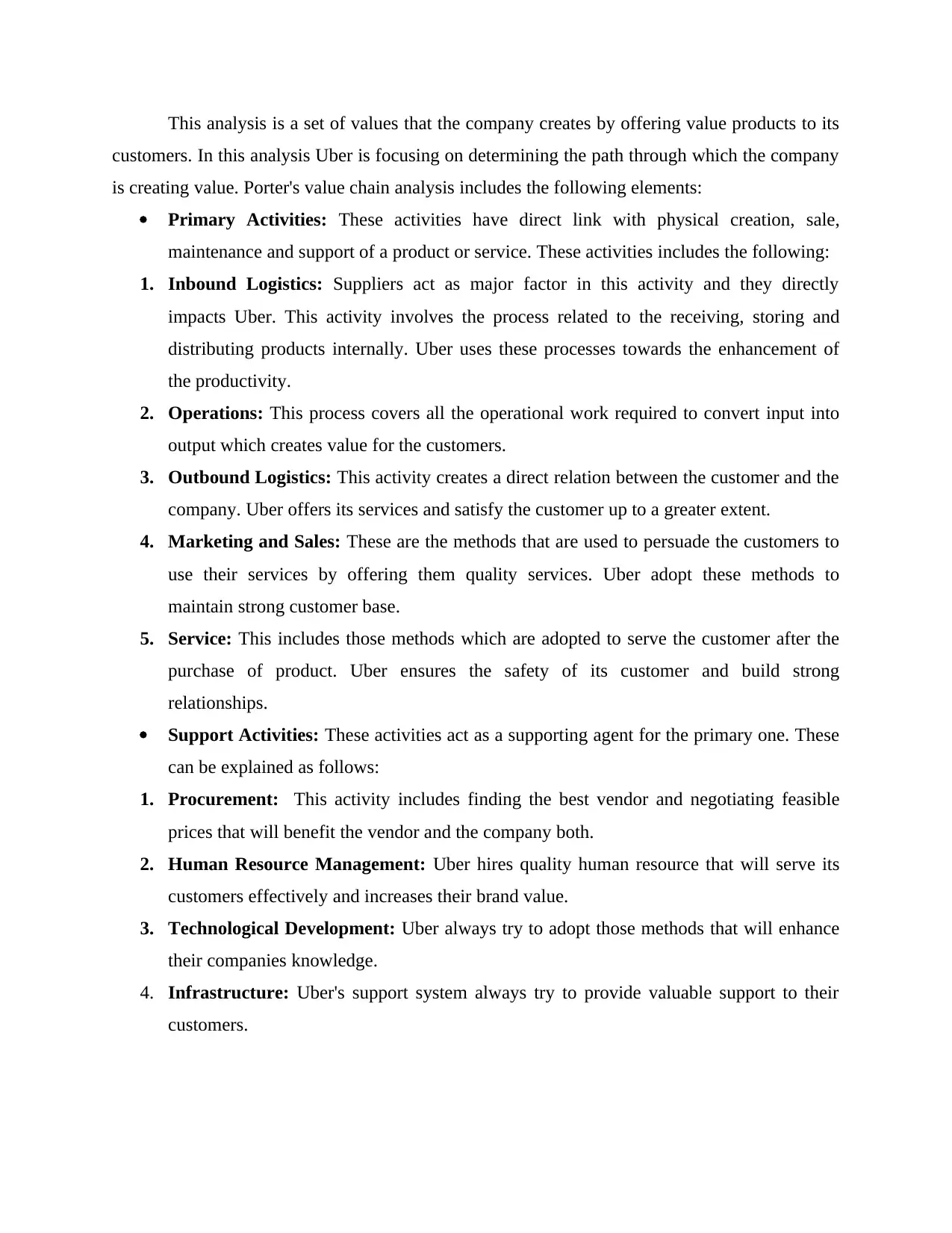
This analysis is a set of values that the company creates by offering value products to its
customers. In this analysis Uber is focusing on determining the path through which the company
is creating value. Porter's value chain analysis includes the following elements:
Primary Activities: These activities have direct link with physical creation, sale,
maintenance and support of a product or service. These activities includes the following:
1. Inbound Logistics: Suppliers act as major factor in this activity and they directly
impacts Uber. This activity involves the process related to the receiving, storing and
distributing products internally. Uber uses these processes towards the enhancement of
the productivity.
2. Operations: This process covers all the operational work required to convert input into
output which creates value for the customers.
3. Outbound Logistics: This activity creates a direct relation between the customer and the
company. Uber offers its services and satisfy the customer up to a greater extent.
4. Marketing and Sales: These are the methods that are used to persuade the customers to
use their services by offering them quality services. Uber adopt these methods to
maintain strong customer base.
5. Service: This includes those methods which are adopted to serve the customer after the
purchase of product. Uber ensures the safety of its customer and build strong
relationships.
Support Activities: These activities act as a supporting agent for the primary one. These
can be explained as follows:
1. Procurement: This activity includes finding the best vendor and negotiating feasible
prices that will benefit the vendor and the company both.
2. Human Resource Management: Uber hires quality human resource that will serve its
customers effectively and increases their brand value.
3. Technological Development: Uber always try to adopt those methods that will enhance
their companies knowledge.
4. Infrastructure: Uber's support system always try to provide valuable support to their
customers.
customers. In this analysis Uber is focusing on determining the path through which the company
is creating value. Porter's value chain analysis includes the following elements:
Primary Activities: These activities have direct link with physical creation, sale,
maintenance and support of a product or service. These activities includes the following:
1. Inbound Logistics: Suppliers act as major factor in this activity and they directly
impacts Uber. This activity involves the process related to the receiving, storing and
distributing products internally. Uber uses these processes towards the enhancement of
the productivity.
2. Operations: This process covers all the operational work required to convert input into
output which creates value for the customers.
3. Outbound Logistics: This activity creates a direct relation between the customer and the
company. Uber offers its services and satisfy the customer up to a greater extent.
4. Marketing and Sales: These are the methods that are used to persuade the customers to
use their services by offering them quality services. Uber adopt these methods to
maintain strong customer base.
5. Service: This includes those methods which are adopted to serve the customer after the
purchase of product. Uber ensures the safety of its customer and build strong
relationships.
Support Activities: These activities act as a supporting agent for the primary one. These
can be explained as follows:
1. Procurement: This activity includes finding the best vendor and negotiating feasible
prices that will benefit the vendor and the company both.
2. Human Resource Management: Uber hires quality human resource that will serve its
customers effectively and increases their brand value.
3. Technological Development: Uber always try to adopt those methods that will enhance
their companies knowledge.
4. Infrastructure: Uber's support system always try to provide valuable support to their
customers.
Paraphrase This Document
Need a fresh take? Get an instant paraphrase of this document with our AI Paraphraser
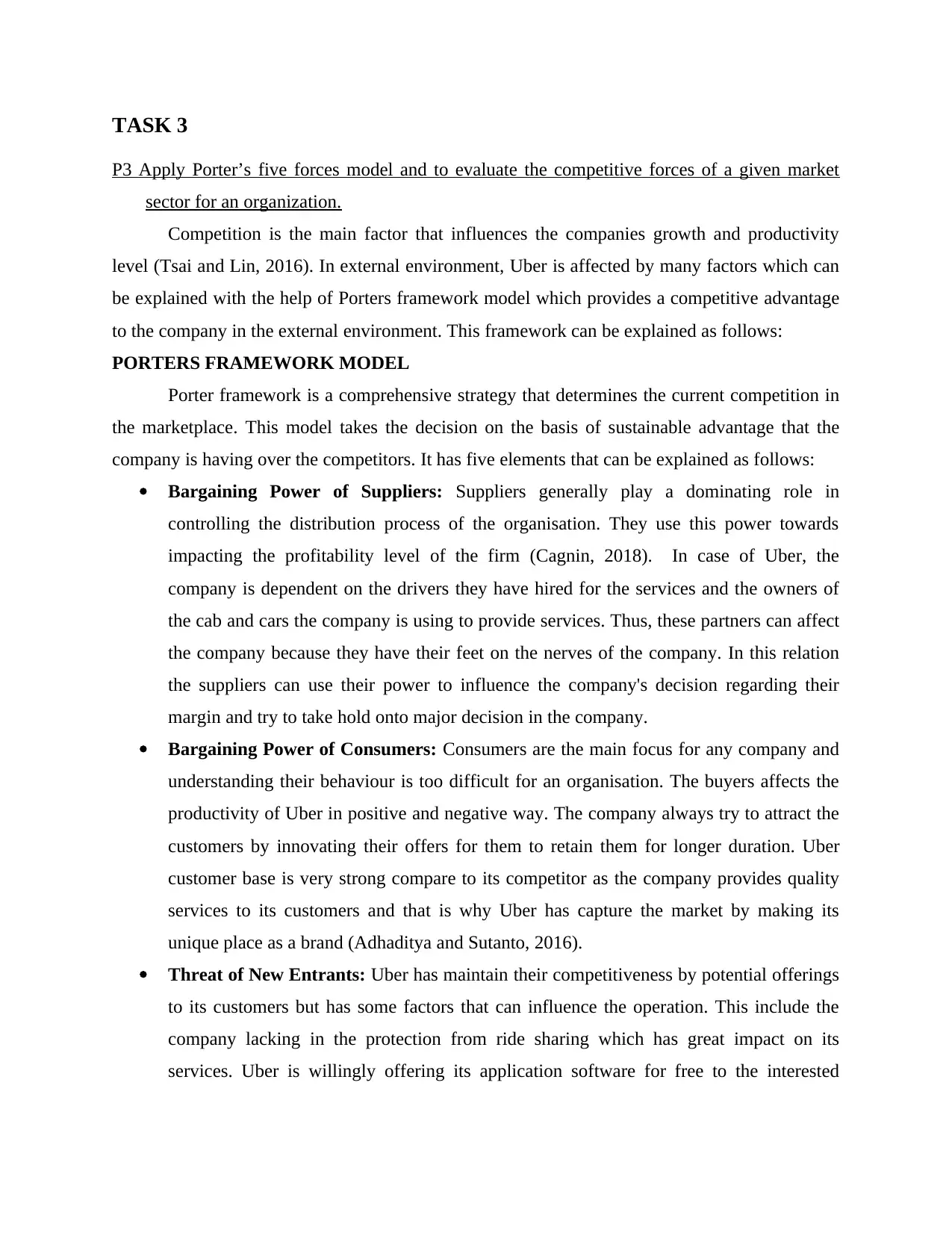
TASK 3
P3 Apply Porter’s five forces model and to evaluate the competitive forces of a given market
sector for an organization.
Competition is the main factor that influences the companies growth and productivity
level (Tsai and Lin, 2016). In external environment, Uber is affected by many factors which can
be explained with the help of Porters framework model which provides a competitive advantage
to the company in the external environment. This framework can be explained as follows:
PORTERS FRAMEWORK MODEL
Porter framework is a comprehensive strategy that determines the current competition in
the marketplace. This model takes the decision on the basis of sustainable advantage that the
company is having over the competitors. It has five elements that can be explained as follows:
Bargaining Power of Suppliers: Suppliers generally play a dominating role in
controlling the distribution process of the organisation. They use this power towards
impacting the profitability level of the firm (Cagnin, 2018). In case of Uber, the
company is dependent on the drivers they have hired for the services and the owners of
the cab and cars the company is using to provide services. Thus, these partners can affect
the company because they have their feet on the nerves of the company. In this relation
the suppliers can use their power to influence the company's decision regarding their
margin and try to take hold onto major decision in the company.
Bargaining Power of Consumers: Consumers are the main focus for any company and
understanding their behaviour is too difficult for an organisation. The buyers affects the
productivity of Uber in positive and negative way. The company always try to attract the
customers by innovating their offers for them to retain them for longer duration. Uber
customer base is very strong compare to its competitor as the company provides quality
services to its customers and that is why Uber has capture the market by making its
unique place as a brand (Adhaditya and Sutanto, 2016).
Threat of New Entrants: Uber has maintain their competitiveness by potential offerings
to its customers but has some factors that can influence the operation. This include the
company lacking in the protection from ride sharing which has great impact on its
services. Uber is willingly offering its application software for free to the interested
P3 Apply Porter’s five forces model and to evaluate the competitive forces of a given market
sector for an organization.
Competition is the main factor that influences the companies growth and productivity
level (Tsai and Lin, 2016). In external environment, Uber is affected by many factors which can
be explained with the help of Porters framework model which provides a competitive advantage
to the company in the external environment. This framework can be explained as follows:
PORTERS FRAMEWORK MODEL
Porter framework is a comprehensive strategy that determines the current competition in
the marketplace. This model takes the decision on the basis of sustainable advantage that the
company is having over the competitors. It has five elements that can be explained as follows:
Bargaining Power of Suppliers: Suppliers generally play a dominating role in
controlling the distribution process of the organisation. They use this power towards
impacting the profitability level of the firm (Cagnin, 2018). In case of Uber, the
company is dependent on the drivers they have hired for the services and the owners of
the cab and cars the company is using to provide services. Thus, these partners can affect
the company because they have their feet on the nerves of the company. In this relation
the suppliers can use their power to influence the company's decision regarding their
margin and try to take hold onto major decision in the company.
Bargaining Power of Consumers: Consumers are the main focus for any company and
understanding their behaviour is too difficult for an organisation. The buyers affects the
productivity of Uber in positive and negative way. The company always try to attract the
customers by innovating their offers for them to retain them for longer duration. Uber
customer base is very strong compare to its competitor as the company provides quality
services to its customers and that is why Uber has capture the market by making its
unique place as a brand (Adhaditya and Sutanto, 2016).
Threat of New Entrants: Uber has maintain their competitiveness by potential offerings
to its customers but has some factors that can influence the operation. This include the
company lacking in the protection from ride sharing which has great impact on its
services. Uber is willingly offering its application software for free to the interested
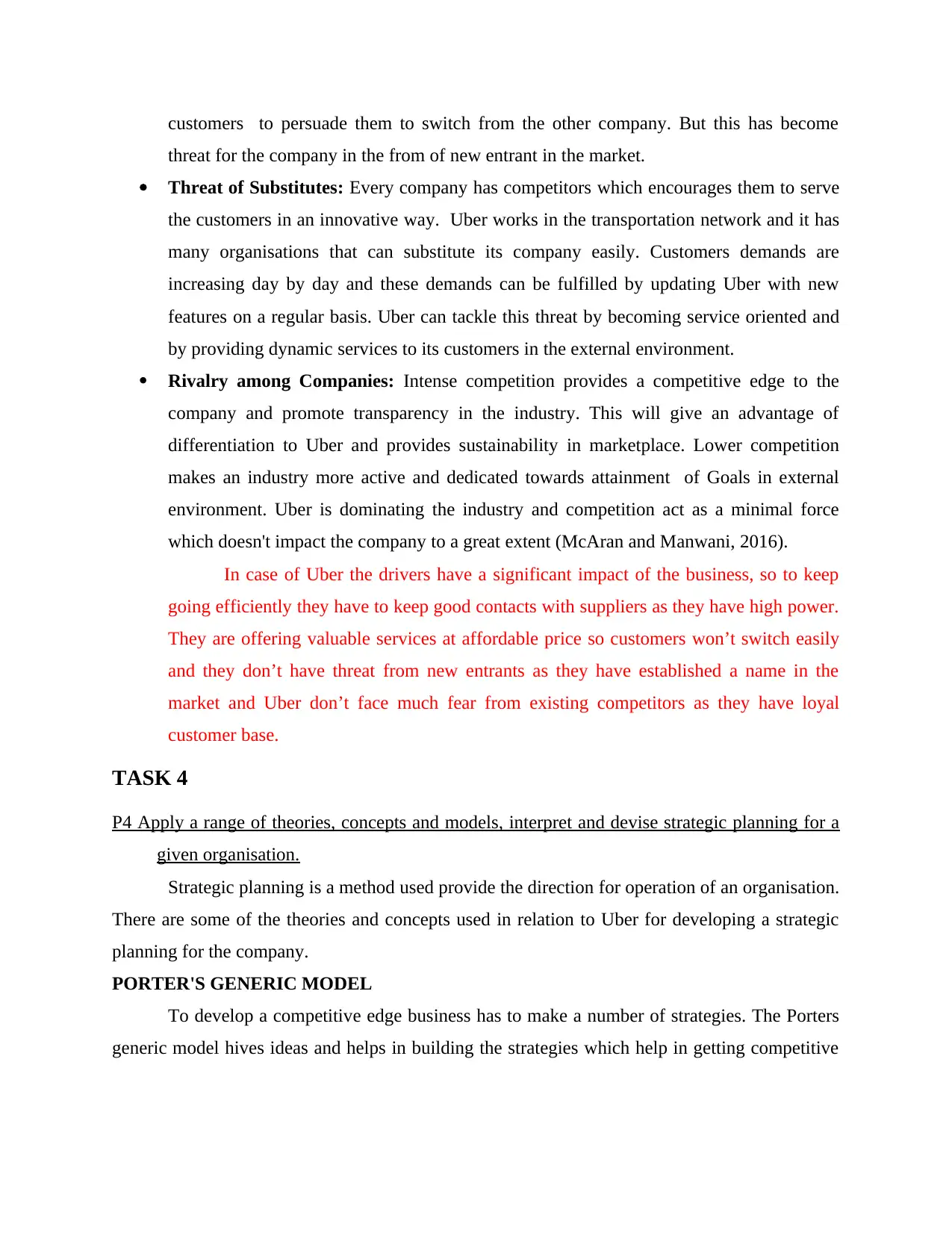
customers to persuade them to switch from the other company. But this has become
threat for the company in the from of new entrant in the market.
Threat of Substitutes: Every company has competitors which encourages them to serve
the customers in an innovative way. Uber works in the transportation network and it has
many organisations that can substitute its company easily. Customers demands are
increasing day by day and these demands can be fulfilled by updating Uber with new
features on a regular basis. Uber can tackle this threat by becoming service oriented and
by providing dynamic services to its customers in the external environment.
Rivalry among Companies: Intense competition provides a competitive edge to the
company and promote transparency in the industry. This will give an advantage of
differentiation to Uber and provides sustainability in marketplace. Lower competition
makes an industry more active and dedicated towards attainment of Goals in external
environment. Uber is dominating the industry and competition act as a minimal force
which doesn't impact the company to a great extent (McAran and Manwani, 2016).
In case of Uber the drivers have a significant impact of the business, so to keep
going efficiently they have to keep good contacts with suppliers as they have high power.
They are offering valuable services at affordable price so customers won’t switch easily
and they don’t have threat from new entrants as they have established a name in the
market and Uber don’t face much fear from existing competitors as they have loyal
customer base.
TASK 4
P4 Apply a range of theories, concepts and models, interpret and devise strategic planning for a
given organisation.
Strategic planning is a method used provide the direction for operation of an organisation.
There are some of the theories and concepts used in relation to Uber for developing a strategic
planning for the company.
PORTER'S GENERIC MODEL
To develop a competitive edge business has to make a number of strategies. The Porters
generic model hives ideas and helps in building the strategies which help in getting competitive
threat for the company in the from of new entrant in the market.
Threat of Substitutes: Every company has competitors which encourages them to serve
the customers in an innovative way. Uber works in the transportation network and it has
many organisations that can substitute its company easily. Customers demands are
increasing day by day and these demands can be fulfilled by updating Uber with new
features on a regular basis. Uber can tackle this threat by becoming service oriented and
by providing dynamic services to its customers in the external environment.
Rivalry among Companies: Intense competition provides a competitive edge to the
company and promote transparency in the industry. This will give an advantage of
differentiation to Uber and provides sustainability in marketplace. Lower competition
makes an industry more active and dedicated towards attainment of Goals in external
environment. Uber is dominating the industry and competition act as a minimal force
which doesn't impact the company to a great extent (McAran and Manwani, 2016).
In case of Uber the drivers have a significant impact of the business, so to keep
going efficiently they have to keep good contacts with suppliers as they have high power.
They are offering valuable services at affordable price so customers won’t switch easily
and they don’t have threat from new entrants as they have established a name in the
market and Uber don’t face much fear from existing competitors as they have loyal
customer base.
TASK 4
P4 Apply a range of theories, concepts and models, interpret and devise strategic planning for a
given organisation.
Strategic planning is a method used provide the direction for operation of an organisation.
There are some of the theories and concepts used in relation to Uber for developing a strategic
planning for the company.
PORTER'S GENERIC MODEL
To develop a competitive edge business has to make a number of strategies. The Porters
generic model hives ideas and helps in building the strategies which help in getting competitive
⊘ This is a preview!⊘
Do you want full access?
Subscribe today to unlock all pages.

Trusted by 1+ million students worldwide
1 out of 18
Related Documents
Your All-in-One AI-Powered Toolkit for Academic Success.
+13062052269
info@desklib.com
Available 24*7 on WhatsApp / Email
![[object Object]](/_next/static/media/star-bottom.7253800d.svg)
Unlock your academic potential
Copyright © 2020–2025 A2Z Services. All Rights Reserved. Developed and managed by ZUCOL.





